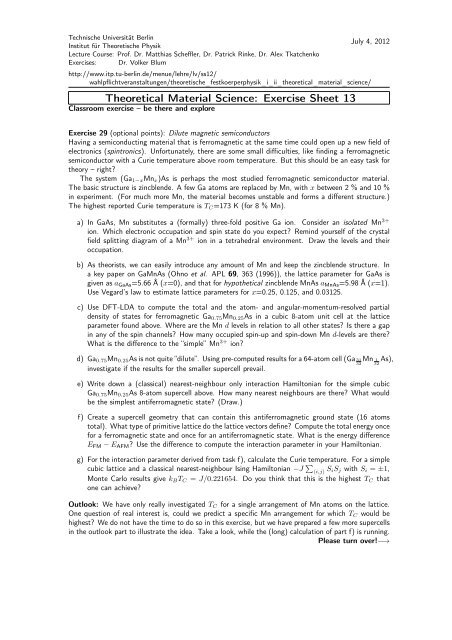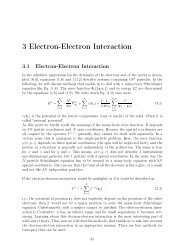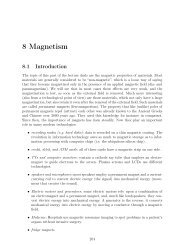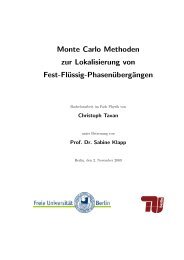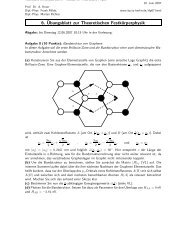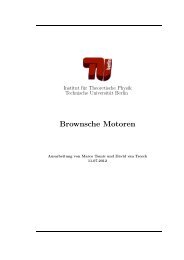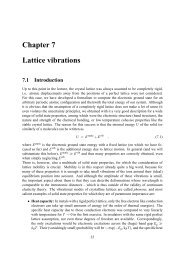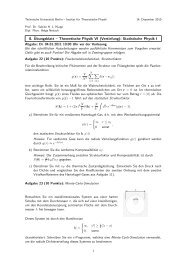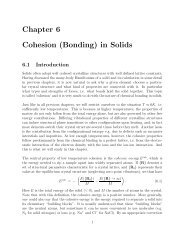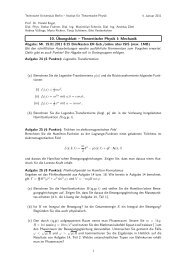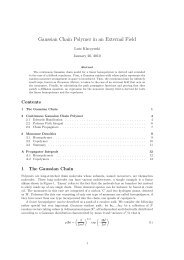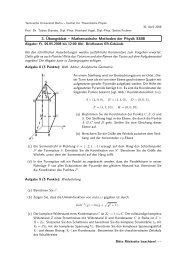Exercise Sheet 13 - Institut für Theoretische Physik - TU Berlin
Exercise Sheet 13 - Institut für Theoretische Physik - TU Berlin
Exercise Sheet 13 - Institut für Theoretische Physik - TU Berlin
You also want an ePaper? Increase the reach of your titles
YUMPU automatically turns print PDFs into web optimized ePapers that Google loves.
Technische Universität <strong>Berlin</strong><br />
<strong>Institut</strong> für <strong>Theoretische</strong> <strong>Physik</strong><br />
Lecture Course: Prof. Dr. Matthias Scheffler, Dr. Patrick Rinke, Dr. Alex Tkatchenko<br />
<strong>Exercise</strong>s: Dr. Volker Blum<br />
July 4, 2012<br />
http://www.itp.tu-berlin.de/menue/lehre/lv/ss12/<br />
wahlpflichtveranstaltungen/theoretische_festkoerperphysik_i_ii_theoretical_material_science/<br />
Theoretical Material Science: <strong>Exercise</strong> <strong>Sheet</strong> <strong>13</strong><br />
Classroom exercise – be there and explore<br />
<strong>Exercise</strong> 29 (optional points): Dilute magnetic semiconductors<br />
Having a semiconducting material that is ferromagnetic at the same time could open up a new field of<br />
electronics (spintronics). Unfortunately, there are some small difficulties, like finding a ferromagnetic<br />
semiconductor with a Curie temperature above room temperature. But this should be an easy task for<br />
theory – right?<br />
The system (Ga 1−x Mn x )As is perhaps the most studied ferromagnetic semiconductor material.<br />
The basic structure is zincblende. A few Ga atoms are replaced by Mn, with x between 2 % and 10 %<br />
in experiment. (For much more Mn, the material becomes unstable and forms a different structure.)<br />
The highest reported Curie temperature is T C =173 K (for 8 % Mn).<br />
a) In GaAs, Mn substitutes a (formally) three-fold positive Ga ion. Consider an isolated Mn 3+<br />
ion. Which electronic occupation and spin state do you expect? Remind yourself of the crystal<br />
field splitting diagram of a Mn 3+ ion in a tetrahedral environment. Draw the levels and their<br />
occupation.<br />
b) As theorists, we can easily introduce any amount of Mn and keep the zincblende structure. In<br />
a key paper on GaMnAs (Ohno et al. APL 69, 363 (1996)), the lattice parameter for GaAs is<br />
given as a GaAs =5.66 Å (x=0), and that for hypothetical zincblende MnAs a MnAs =5.98 Å (x=1).<br />
Use Vegard’s law to estimate lattice parameters for x=0.25, 0.125, and 0.03125.<br />
c) Use DFT-LDA to compute the total and the atom- and angular-momentum-resolved partial<br />
density of states for ferromagnetic Ga 0.75 Mn 0.25 As in a cubic 8-atom unit cell at the lattice<br />
parameter found above. Where are the Mn d levels in relation to all other states? Is there a gap<br />
in any of the spin channels? How many occupied spin-up and spin-down Mn d-levels are there?<br />
What is the difference to the “simple” Mn 3+ ion?<br />
d) Ga 0.75 Mn 0.25 As is not quite “dilute”. Using pre-computed results for a 64-atom cell (Ga31<br />
32 Mn 1<br />
32 As),<br />
investigate if the results for the smaller supercell prevail.<br />
e) Write down a (classical) nearest-neighbour only interaction Hamiltonian for the simple cubic<br />
Ga 0.75 Mn 0.25 As 8-atom supercell above. How many nearest neighbours are there? What would<br />
be the simplest antiferromagnetic state? (Draw.)<br />
f) Create a supercell geometry that can contain this antiferromagnetic ground state (16 atoms<br />
total). What type of primitive lattice do the lattice vectors define? Compute the total energy once<br />
for a ferromagnetic state and once for an antiferromagnetic state. What is the energy difference<br />
E FM −E AFM ? Use the difference to compute the interaction parameter in your Hamiltonian.<br />
g) For the interaction parameter derived from task f), calculate the Curie temperature. For a simple<br />
cubic lattice and a classical nearest-neighbour Ising Hamiltonian −J ∑ 〈i,j〉 S iS j with S i = ±1,<br />
Monte Carlo results give k B T C = J/0.221654. Do you think that this is the highest T C that<br />
one can achieve?<br />
Outlook: We have only really investigated T C for a single arrangement of Mn atoms on the lattice.<br />
One question of real interest is, could we predict a specific Mn arrangement for which T C would be<br />
highest? We do not have the time to do so in this exercise, but we have prepared a few more supercells<br />
in the outlook part to illustrate the idea. Take a look, while the (long) calculation of part f) is running.<br />
Please turn over!−→
<strong>13</strong>. <strong>Exercise</strong> TFK I+II SS 2012 June <strong>13</strong>, 2012<br />
• Webpage of the lecture:<br />
http://www.itp.tu-berlin.de/menue/lehre/lv/ss12/<br />
wahlpflichtveranstaltungen/theoretische_festkoerperphysik_i_ii_theoretical_material_science/<br />
http://th.fhi-berlin.mpg.de/sitesub/lectures/spring_2012/<br />
• Lecture: Tue. & Wed., 10:00 h -12:00 h (sharp!) in room EW 203, <strong>TU</strong> <strong>Berlin</strong><br />
• <strong>Exercise</strong>: Wed., 14:00 h in room EW 229<br />
• Literature:<br />
– Ashcroft, Mermin, David: Solid state physics, Saunders College, Philadelphia, 1981<br />
– Kittel: Quantum theory of solids, Wiley, New York, 1963<br />
– Ziman: Principles of the theory of solids, Cambridge University Press, Cambridge, 1964<br />
– Ibach, Lueth: Solid-state physics: an introduction to principles of materials science, Springer,<br />
<strong>Berlin</strong>, 1995<br />
– Madelung: Festkörpertheorie, Springer, <strong>Berlin</strong>, 1972<br />
– Scherz: Quantenmechanik, Teubner, Stuttgart, 1999<br />
– Dreizler, Gross: Density functional theory: an approach to the quantum many-body problem,<br />
Springer, <strong>Berlin</strong>, 1990<br />
– Parr, Yang: Density-functional theory of atoms and molecules, Oxford University Press,<br />
Oxford, 1994<br />
– Anderson: Basic notations of condensed matter physics, Benjamin/Cummings, London,<br />
1984<br />
– Marder: Condensed matter physics, Wiley, New York, 2000<br />
– Martin: Electronic Structure, Cambridge University Press, Cambridge, 2004<br />
– Kohanoff: Electronic Structure Calculations for Solids and Molecules: Theory and Computational<br />
Methods, Cambridge University Press, Cambridge, 2006<br />
• ”Übungsschein“-criteria:<br />
– Regular and active participation in the exercises<br />
– Presentation of homework tasks and<br />
– 50% of the homework points.<br />
– Active participation in computational exercises<br />
• Consultation hours:<br />
– Prof. Dr. Matthias Scheffler, Dr. Alex Tkatchenko, Dr. Patrick Rinke: by appointment<br />
– Dr. Volker Blum: Available Wed. 16:00 (after the exercise class) or by appointment


